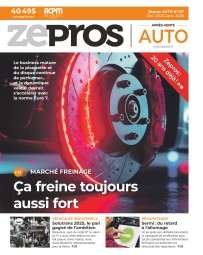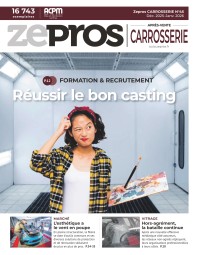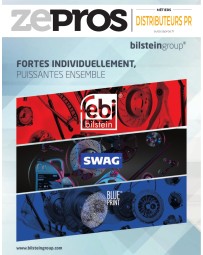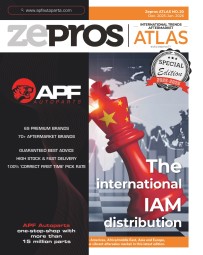
“We should take advantage of our startup mindset to challenge ourselves!”
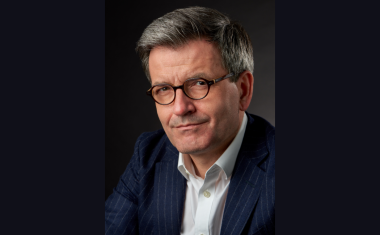
After ten years of dazzling growth, Nexus Automotive International, led by its founder Gaël Escribe, has irremediably established itself. But this centralized purchasing centre
is still irrigated by this state of mind of an effervescent startup conquering the world, even if it means challenging itself…
Which parts of the world were the most dynamic in 2024 for NEXUS Automotive International?
Gaël Escribe: Europe, with its aging parc, has been a significant force for our members, accounting for 55% of global turnover, estimated at €50 billion by the end of the year. Our European partners operate highly agile companies that enable them to adapt swiftly. I also recognise the vitality in Latin America and the United States, despite the US market experiencing a decline in the first half of the year. We maintain a strong market share in the wholesale segment in North America and plan to continue expanding here. However, there are still areas where performance falls short, such as Africa, a crucial emerging territory for NEXUS since its inception in 2014. We face increasing competition from China in a market with high demand. While we should perform well, our partner suppliers lack the agility to effectively address this market.
Chinese pragmatism prevails over a lack of agility in Europe?
GE: We’ve been sounding the alarm on this issue for years. European recipes simply aren’t adaptable to the African market. This inertia forced us to create IAMaga in 2020, headed by Martin Hendriksen, to address this challenge. We’re bolstering our structure with the arrival of suppliers SKF and Spanjaard Ltd., a local partner, and the acquisition of BTR.
We’ve also strengthened IAMaga’s commercial structure by organising the One Africa Business Summit by IAMaga in 2024 and the NEXUS Africa Connecting Day in Johannesburg in November. Additionally, we’ve just announced the launch of the Africa Feeder project, which aims to combat counterfeit products, simplify supply chains, reduce trade barriers, and share freight rates. IAMaga currently has approximately a hundred African members and holds a 90% market share. However, some offers from certain equipment manufacturers still don’t align with local market demands. NEXUS is the intermediary that must provide solutions promptly. Will we continue to work with our usual partners or explore alternative approaches? We’ll soon answer this question.
Southeast Asia is also among the disappointing areas?
GE: Indeed. China has recovered, and we are present there with a respectable performance. The country will develop its own distinctive after-sales model, and we will eventually collaborate with Chinese equipment manufacturers. On the other hand, we still have much to learn in Southeast Asia, as our presence is not yet comparable to these markets. In Malaysia, specifically in Kuala Lumpur, we organized a Connecting Days event for the NEXUS community. We are also present at Automechanika Shanghai. However, this is our final frontier to conquer. We face the same challenges of compatibility between suppliers and the market as we did in Africa. I believe we will replicate our success there by establishing local partnerships. Indonesia and the Philippines are vast territories to look into.
What concrete actions have you taken with Stellantis since the first half of the year?
GE: Sourcing and purchasing with Stellantis presents the first significant competitive challenge to achieve scale effects for older parcs. The volume effects are already substantial, particularly within SmartParts. We have also signed an agreement in the United States for the distribution of specific ranges such as Mopar or bprauto ® within NEXUS North America. We are now working in Europe with pilot markets to develop distribution channels with Stellantis products, with or without Distrigo.
Another priority is supplying parts from NEXUS distributors to Stellantis networks when they don’t have the part, as per local agreements. Or the scale effects permitted between our respective repair networks, particularly through the Service Next technology, acquired by NEXUS on 1 January. Several projects are underway and progressing well.
• €50 billion in cumulative turnover at the end of the year
• 143 countries
• 515 members• 2,311 distribution points
• 16 regional structures
In the United States, which accounts for 50% of your turnover, you’re establishing a head office in Dallas, Texas. What’s the prerequisite to fully unlock this market?
GE: To make a significant impact in the American market, we must set ambitious goals and deliver exceptional results. Our presence in the market since 2015 has been promising, but establishing ourselves locally will provide us with a deeper understanding of the expectations of local equipment manufacturers. By actively engaging with the local ecosystem, we are not only demonstrating our commitment to growth but also fostering meaningful connections with suppliers daily. This collaborative approach will enable us to better support European companies seeking to establish themselves in the United States and assist American companies in their geographic expansion.
How will you transition from a centralized purchasing centre to a group, the objective announced last year?
GE: We are supported by a consulting firm. The NEXUS model will be neither that of an ITG nor that of a group; it will be a hybrid and agile model. Agility is crucial in the aftermarket business, and we are witnessing this today with the poor performance of the large, consolidated players. NEXUS must develop a new model that adapts to the global evolution of the aftermarket. We aspire to transcend our role as a mere connector between suppliers, whom we are accountable to, and the market. In 2025, we should be able to outline the broad contours of this evolution, which is crucial given the dynamics of the aging parc and the rapid advancements in artificial intelligence, among other factors. Let’s also capitalise on our startup mindset, considering we’re only a decade old. This should motivate us to challenge ourselves and evolve in a systematic manner, ultimately leading us to achieve group status. However, it remains to be seen how we’ll finance this transformative journey.
What are the most critical areas where errors are unacceptable?
GE: Technology, innovation, and digitalization—let’s not overlook these crucial topics. That’s why we took the lead with manufacturers, starting with Stellantis and others who followed. We must strike a balance with them, as their needs and ours are intertwined. To achieve this, we’ve established a structure with a Key Account Manager to facilitate exchanges, provide added value, and collect data for operational insights. Collaborating is essential, especially in today’s rapidly evolving world where ultra-digitalisation and AI are gaining momentum. We are also going to integrate Autodoc, a major player within our digital division.
